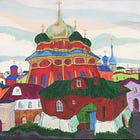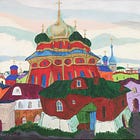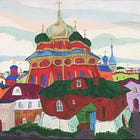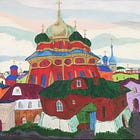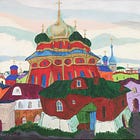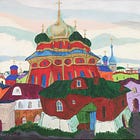Index Page, Ancient to pre-Soviet Russian History, in 6 chapters
Recommended by scientific-methodical council of UrSEU as a teaching complex for students of the correspondence form of training
This book explains the Russian stereo-type as related to the landscape and the ancient traditional practices. It talks about the eventual unification of Russia from the internal and surrounding principalities. It explains the strategic and security concerns throughout the centuries. It details the various repressions and their softening (not too much softening), and may relate that to the consolidation of power and how that power managed the nation.
It is in no way a justification of this trajectory. This is how it happened. Could it have happened in another way? The justification or condemnation belongs to you, and to your sensibilities, after you have seen what Russia went through.
_______________
This is the first Russian history that I translated, two or three years ago. I started slowly and with hesitation because it seemed like a lot of work just to read a book.
My source for the Russian text was: https://studopedia.su/ Those original files have been taken down. It was strange to me that the book was on about 35 web pages, going to “next” . . . “next” . . . “next”. I guessed that they wanted to get a lot of advertising impressions, and were making some money on that. In fact a message kept coming up “please turn off your add-blocker”.
This site gives advice to students, and I think that they will even write a theme paper for you. (sell it to you) It is a job for some college graduates in history.
Educational and methodical complex Here are some of the authors that compiled this book: Russian history: / Compiled by. I.V. Borzikhina, M.A. Velboy, N.D. Zapetskaya, L.A. Konopleva, V.M. Kulikov, I.L. Martyushova, A.V. Trofimov, E.A. Tsypina, A.V. Shilovtsev, T.E. Eydis. Edited. by A.V. Trofimov. 4th Edition, revised and supplemented. Ekaterinburg: Publishing house of Ural State University of Economics, 2003.
“This guide contains factual and analytical material on college courses of "Russian history", which meets the requirements of federal educational standards and takes into account the possibilities of multi-conceptual approach. It provides the test assignments as well as seminar plans and study materials to prepare for them, designed for the students of extramural form of education. 2003 (Yes, there are some sample student tests in here, I guess that I will reproduce them.)
Russia, like a large tree, has a large root system and a large deciduous crown, touching the crowns of other trees. We do not know the simplest things about ourselves. And we don't think about those simple things.”
D.S.Likhachev
I will divide the book into about 6 sections, the links are below. It starts with an essay about history; “The subject, categories, and essence of historical knowledge”. I will post it first, but it might be to read later, after getting into the book.
Most of my posted books are by Lev N. Gumilev, but as you see I have other favorites too.
"The subject, categories, and essence of historical knowledge"
This section lays out the Territorial and climatic factors, and the strategic, security, and religious factors that shaped the Russian cultural mind-set, (stereo-type of behavior.)
At the turn of XV - XVI centuries a Russian centralized state emerged.
The first Tsar's title, undermined the possible attempts of feudal princes to co-reign, and the building of state institutions.
One of the most active tsars was Peter the Great, 1682 -1725. In the first quarter of the 18th century the absolute monarchy was legally established. Then followed a period of chaos.
Through the Swedish and Turkish wars, Russia gained access to the sea. The 19th century Socio-political thought in Russia and the growing internal crisis in Russia, and the Napoleonic war
The Reform of 1861 was a result of a compromise, but the peasant landlessness remained, and now the peasants were burdened with the redemption payments. Much history until the 1917 overthrow of the Tsar. END OF THIS BOOK


